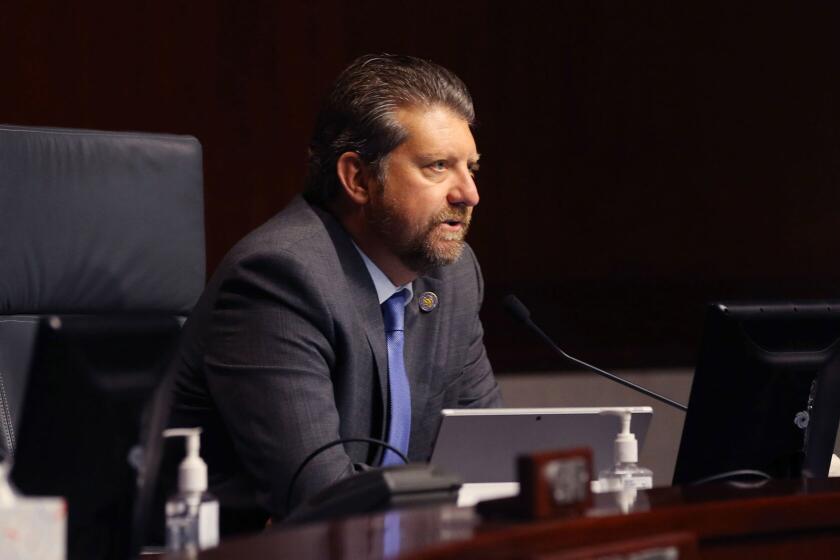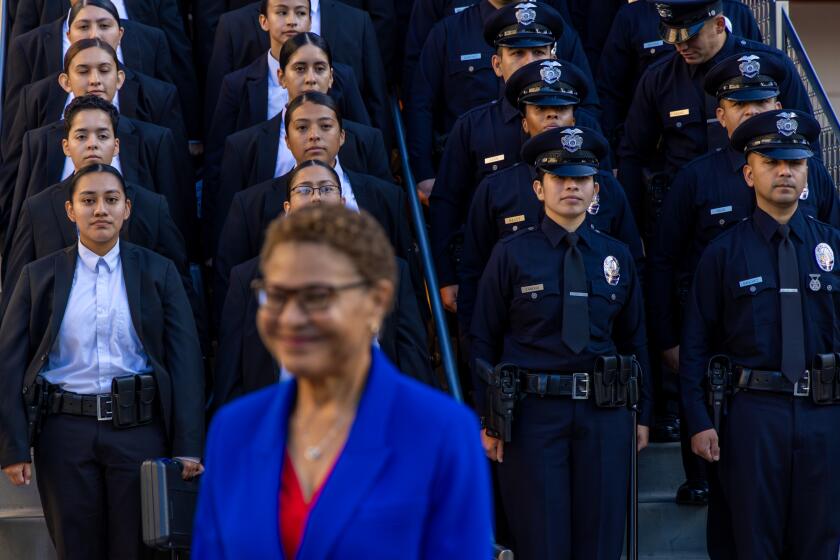How Linda McMahon’s mission to dismantle the Education Department could affect California

- Share via
* In nomination hearing, she tells senators of her vision for department, which includes shutting it down.
*California gets billions in federal education funding. Will that money still find its way to the state under Trump administration?
Linda McMahon, President Trump’s nominee to head the U.S. Department of Education, stood in solidarity Thursday with his goal of dismantling the department — an overhaul that could affect how billions of dollars in K-12 funding, financial aid and student loans flow to California schools and colleges.
McMahon told lawmakers during her Senate confirmation hearing that federal funding for students in need would continue — including Title I funding for schools that serve low-income families and funds for students with disabilities. The Education Department also assists low-income college students, students who are learning English and protects students’ civil rights.
It is unclear whether Trump will tie funding to states’ adherence to his orders, including banning transgender athletes from competing on girls’ and women’s teams and stopping diversity, equity and inclusion programs.
Linda McMahon sketched out how key functions of the Education Department could be carved up to achieve President Trump’s goal of dismantling it.
President Trump, McMahon said, “pledged to make American education the best in the world, return education to the states where it belongs, and free American students from the education bureaucracy through school choice.”
McMahon’s hearing in Washington, D.C., took place the day after Trump commented that the department should be be shut down “immediately,” calling it “a big con job” based on the level of government spending on education and the nation’s overall poor results on standardized tests when compared with other countries.
The Education Department has a budget this year of about $79 billion. California, with about 5.8 million public-school students, has received about $16.3 billion in total federal funding, or $2,748 per pupil, according to Education Data Initiative, which compiles information from government sources. The figures also include education-related spending outside of the U.S. Department of Education, such as expansive school meal programs and Head Start for preschoolers.
Here’s what the U.S. Department of Education does for California and what McMahon said Thursday about its future:
K-12 anti-poverty funds
California educators are deeply concerned about how any dismantling would affect the Title I program, which provides K-12 funding to offset the effects of poverty. The department helps to distribute and oversee more than $18 billion in Title I grants.
The state receives more than $2.1 billion in Title I grants, with $417 million provided to Los Angeles Unified, the nation’s second-largest school system, according to the California Department of Education.
Congress established the grant program in 1965 in recognition that local school-funding systems favored wealthier communities because they typically relied on property taxes. Congress also believed that low-income students needed more resources to learn successfully.
In her testimony, McMahon said Title I funding, appropriated by Congress, would be protected, but could be distributed without an Education Department.
It’s not clear what if any federal oversight would be attached to these funds. Project 2025, a Heritage Foundation project that outlined education goals that appear to be aligning closely with the new administration, called for gradually phasing out Title I grants over about 10 years.
College financial aid: Pell Grants
The department awards more than $120 billion to 13 million students each year to help pay for higher education costs. The figure includes college loans, work-study funds and grants.
The largest program provides Pell Grants, which do not have to be repaid, to students with low family incomes. In 2024-25, the maximum Pell Grant was $7,395.
McMahon pledged to support Pell Grants, while also hoping to establish a similar program for career and technical training that does not require attending a four-year university.
Within the Education Department, more than $1.5 billion is currently set aside for such grants to California students.
“Defunding is not the goal here,” McMahon said. “I’d actually even like to see an expansion of Pell Grants.”
There appears to be bipartisan agreement that this funding should survive. Without an Education Department, the program could, for example, be transferred to the U.S. Department of the Treasury.
More than 80,000 University of California undergraduate students received about $454 million in Pell Grants in the 2023-24 academic year.
About 47% of California State University undergraduates — 204,000 students — received more than $1 billion in Pell Grants in the fall of 2022, the most recent data published. Among California community college students, 19% received the federal award in 2022-23.
Student loans and financial aid applications
The Education Department oversees the Free Application for Federal Student Aid, or FAFSA, to determine what kind of federal loans and grants college students are eligible to receive.
A revised FAFSA, meant to be easier, turned out to be a debacle last year. The system was beset by glitches, data entry problems and delays, leading to a 9% dip in first-time aid submissions. This year, many of the problems seem to have been resolved.
Under the Biden administration, the federal government attempted a massive student loan forgiveness program, with limited success. Key Trump allies opposed these efforts, which are unlikely to continue. There also could be a substantial shift from the government to private lenders, with or without a federal Education Department.
According to the Education Department, the government is owed more than $1.5 trillion in student loans by more than 43 million Americans.
Changes to the loan programs would affect hundreds of thousands of California students and loan holders.
At California State University campuses, 107,000 students have taken out $861 million in federal student loans and thousands of others receive supplemental grants and federal work-study awards.
Civil rights
The Office for Civil Rights enforces federal laws prohibiting discrimination in educational programs or activities that receive federal funding. Without a Department of Education, civil rights enforcement would probably transfer to the U.S. Department of Justice.
Under federal education law, Title VI bars discrimination on the basis of race, color or national origin, while Title IX prohibits bias based on sex.
Enforcement of Title IX in sexual misconduct cases has been particularly fraught by politics. President Obama emphasized the rights of sexual misconduct victims. In his first term, President Trump tacked in a different direction, emphasizing the due-process rights of those accused of misconduct. President Biden’s approach was closer to Obama’s.
Trump has reinstated his earlier policies, and universities responding to complaints of sexual misconduct will have to conduct hearings and provide more protections for accused students. However, a California court affirmed the right to those protections for all students in both public and private institutions in 2019, prompting UC, CSU, USC and others to incorporate them in their Title IX processes.
Conservatives argue that civil rights enforcement would be less politicized within the Department of Justice. However, it isn’t clear that a change in venue would eliminate political influence, especially under a Trump administration that appears to be purging those perceived as political or ideological opponents.
Also, the Biden administration had expanded the groups of those protected from sex discrimination to include gender identity — bringing in the LGBTQ+ community under the umbrella of Title IX protections. The Trump administration ended that expansion. Trump has also banned transgender athletes from girls’ and women’s sports.
This week he authorized the Education Department to launch a Title IX investigation into the California Interscholastic Federation for its policy allowing transgender high school athletes to play girls’ sports,
Her Education Department, McMahon said, “will stop forcing schools to let boys and men into female sports and spaces, and it will protect the rights of parents to direct the moral education of their children.”
With or without an Education Department, the focus of federal civil rights enforcement appears headed for change.
California has its own laws protecting civil rights for LGBTQ+ individuals. It’s not clear what will happen as state laws collide with federal policy and Gov. Gavin Newsom has pledged to uphold California laws against federal incursions.
In recent years, the Office for Civil Rights has focused increasingly on investigating allegations of antisemitism, anti-Arab bias and other complaints of discrimination based on race and shared ancestry.
UCLA suspended two pro-Palestinian campus groups after a protest at a UC regent’s home, which was vandalized. Chancellor Julio Frenk said students violated conduct rules. The groups said they were undeterred.
At McMahon’s hearing, Republican senators, echoing Trump, concentrated on college campus antisemitism — with no mention of anti-Arab bias. They spoke of expelling foreign-born students who infringed on the safety and education of Jewish students. And they wanted to know if McMahon would be an ally in threatening to strip federal funds from colleges that tolerate a hostile environment.
She promised her full commitment.
“We must protect all students from discrimination and harassment, and if I am confirmed, the department will not stand idly by while Jewish students are attacked and discriminated against,” McMahon said.
Even without a confirmed leader, Trump’s Department of Education has opened antisemitism inquiries at five colleges, including Columbia and UC Berkeley.
Dollars for the disabled and more
States receive more than $14 billion to serve students with disabilities. About $1.33 billion of that goes to California. There’s also more than $4 billion nationally to help individuals with disabilities become gainfully employed and $36 million for the Special Olympics.
Sen. Maggie Hassan (D-N.H.) said federal oversight of education for the disabled, through a Department of Education, needs to continue. Prior to federal mandates, “state and local schools did not educate these kids” because it’s hard, Hassan said. “It takes a national commitment to get it done.”
A key question will be which funds are mandated by Congress. Repeating a theme, McMahon said it would be her intention to follow the law, which includes the Constitution’s stricture that Congress controls the purse strings.
On Monday, a government-efficiency team led by Elon Musk, announced on social media that the Education Department had “terminated” 89 contracts, as well as 29 grants associated with diversity and equity training. The cuts appeared to fall heavily on the department’s research arm.
The canceled funding also included a training grant to address a teacher shortage in Virginia, said Sen. Tim Kaine (D-Va.) at the hearing.
McMahon said she had no ability to evaluate that situation from the outside, but that it’s her understanding that members of Musk’s group had become Education Department employees so they were not outside actors forcing decisions on the department.
Other grant programs in the department’s portfolio include $8 billion for the “academic acceleration” of “underserved students.” About $900 million is provided to help students of other languages become fluent in English. In addition, federal aid is provided to help veterans enroll in postsecondary programs and complete them.
One area of uncertainty involves what Trump will do with grant programs that serve Black, Latino, Asian American and other minority students. Nearly $230 million in grants, for instance, is provided to higher education institutions with a Latino student population of 25% or more — which includes 21 of 23 CSU campuses and five of nine UC undergraduate campuses.
But Trump’s recent executive order to eliminate diversity, equity and inclusion programs has raised questions about the fate of these initiatives.
Early education
While the majority of programs related to child care and early education are housed within the Department of Health and Human Services — including Head Start and child-care subsidies for low-income families — the Department of Education also provides support.
The department oversees the Individuals with Disabilities Education Act, which includes funding for infants, toddlers and preschoolers with disabilities or developmental delays. California receives about $100 million in grants annually to provide services for 103,000 young children. This includes funding for school-based aides as part of an individualized education program, or IEP, as well as the speech and occupational therapists who work at Head Starts.
The department also administers a smaller program that funds child-care services on college campuses for low-income student parents. California receives about $16 million to help fund child-care centers at more than 40 campuses across the state.
More to Read
Sign up for Essential California
The most important California stories and recommendations in your inbox every morning.
You may occasionally receive promotional content from the Los Angeles Times.
















